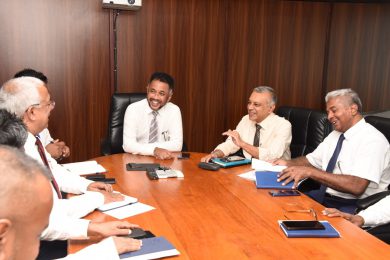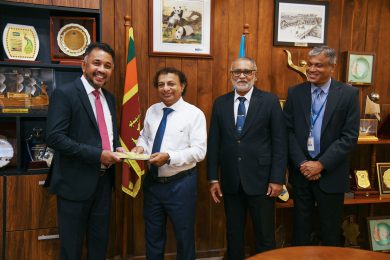Supply chain requirements have changed in recent years. Today, to satisfy higher demands, better track the movement of cargo and respond to issues, supply chain stakeholders are focussing more on the ways to improve the visibility, quality and security of their containers.
Following excerpt adapted from a paper originally published in Global Infrastructure Hub
Smart containers are shipping containers used in freight and logistics that are integrated with Internet of Things (IoT) technologies, sensors, GPS tracking and solar panels. The containers are designed to regulate the internal conditions (e.g. temperature), provide real time GPS tracking, enhance security, and provide condition information that can alert operators to any potential issues with the cargo. The information gathered is automatically fed into digital shipment records, which can be shared with the customer to provide up to date tracking and can be used to better predict arrival times at ports to enable optimized unloading of containers and distribution to the next phase of the supply chain. Smart shipping containers can be self-powered by solar panels on their exterior and have batteries to enable energy to be stored.
Traditional means of tracking the progress of shipping containers are heavily manual and unreliable. Information provided is consistently outdated, which makes it difficult to accurately predict the containers arrival time at the port. This can lead to congestion at the port and delays in unloading the cargo for the next stage in the supply chain. The data collection process is very costly, prone to error, incomplete and can be fraudulent. Smart Containers can relay the data automatically and in real-time during transportation and provide accurate information that enables port operators to better plan their facilities for incoming shipments, storage and onward distribution.
Supply chain requirements have changed in recent years. Today, to satisfy higher demands, better track the movement of cargo and respond to issues, supply chain stakeholders are focussing more on the ways to improve the visibility, quality and security of their containers. The IoT technology inherent in Smart Containers can provide accurate real-time data about the condition, location and the environment directly to the operators. While refrigerated containers have existed for some time, they were limited in that they only allowed operators to set temperature conditions inside containers at the start of transport, to maintain the quality of perishable goods (such as food or medication). Smart Containers improve upon this technology. Operators can track, remotely control and adjust the internal conditions as required. This enables the temperature to be adjusted in response to fluctuations in the container’s external environment, which may vary dramatically during its transportation. The data collected can be used to demonstrate the goods have remained within regulated temperature thresholds throughout their journey. They can also detect movements nearby and enable burglary prevention systems.
Another issue related to traditional shipping container operations occurs
when they arrive and are unloaded at ports. Containers can be left on docks or
delivered to the wrong port; these problems are usually discovered months after
the occurrence. Smart Containers can solve this problem by providing real-time information to the authorities to enable rapid issue
detection.
Autonomous Shipping Ports (see also the Autonomous Shipping Ports Use Case) and Autonomous Shipping Vessels are also developing in many countries. With these additional developments, in the near future, Smart Containers will be able to communicate directly with the autonomous systems on ships and at ports. This will result in streamlined, error-free and efficient operations from start to finish.
VALUE CREATED
Improving efficiency and reducing costs:
- Reduce the time required to gather data on the location and condition of containers by implementing an autonomous system that provides automatic updates.
- Enhance productivity and reduce the cost associated with lost or damaged cargo by ensuring optimized operations and reducing the probability that containers will be damaged or lost.
- Minimise the cost related to wastage by extending container’s life with technologies and reducing theft and spoilage of goods by utilizing temperature control and anti-theft functionalities.
Enhancing economic, social and environmental value:
- Enhance safety and security of cargo and improve customer service by tracking the container’s location and condition information and providing real time data enabling better optimization of the entire supply chain.
POLICY TOOLS AND LEVERS
Legislation and regulation: Government and industry must develop standards for Smart Containers such as testing equipment to ensure the quality of the goods, effective technologies and safe operation of the Smart Containers.
Effective institutions: The supply chain must have a secure communication system to transfer data between the Smart Containers and the operators. In addition, collaboration between the logistics companies and product suppliers is important to understand the requirements in conditions of the goods during transportation thereby ensuring the quality of the goods.
Transition of workforce
capabilities: Several capabilities in areas such as technical engineering,
software engineering and system integration are required across the production,
management and maintenance of the Smart Containers. While the production of the
containers would be outsourced, the management and maintenance of the containers could be achieved
in-house and would therefore require
the upskilling of staff to meet this need.
IMPLEMENTATION
| Ease of Implementation: As Smart Containers are shipping containers with IoT technology integrated, all types of containers can be converted to Smart Containers. Electronics and/or devices can be retrofitted for existing containers or built in during manufacture for new containers. Many companies around the world (e.g. Mediterranean Shipping Co. and Telenor) are already making the transition to Smart Containers. | |
| Cost: The capital expenditure requirement of the Smart Containers is more than the cost of a traditional container due to cost of the additional technologies. However, the cost of the sensor technology is relatively low and is decreasing over time. The subsequent operational expenditure will be reduced as a result of the reduction in staff, the optimization of tracking, and the knock- on improvement in planning and decline in damaged, lost or spoiled cargo. | |
| Country Readiness: Data transmission and long distant communication will require a secured and speedy communication network (satellite-based or internet-based network). The coverage of the communication network will need to expand in order to transmit and receive real-time data. | |
| Technological Maturity : IoT technology is used widely in different applications such as cars, houses and phones. The technologies are mature enough to meet container and service demands. For example, Mediterranean Shipping Co. is committed to 50,000 Smart Containers by 2020. It is predicted that about 10% of container fleets around the world will be outfitted as Smart Containers by 2023. |
RISKS AND MITIGATIONS
Implementation risk
Risk: Containers are made of steel and usually stacked several deep on shipping vessels. This can interrupt communication between the container and the operator, which can make the data inaccurate or lost.
Mitigation: The quality of the data transmission depends on the communication network. The network may need to be upgraded to improve coverage to ensure data can always be transmitted.
Social risk
Risk: The implementation of Smart Containers may result in redundancies for existing employees. Since Smart Containers can obtain real-time data automatically while at sea, the traditional manual work is eliminated. This could have consequences for the company such as negative press and impact to the brand’s reputation.
Mitigation: With the new technologies installed, the work on shipping vessels will become more technical. There is an opportunity to upskill employees to meet this need. Companies should also develop a strategy to deal with human resources changes any potential media response.
Safety and (Cyber)security risk
Risk: Smart Containers generate data and communicate with authorities through a satellite-based or internet- based system. Therefore, there is a risk that data collected could be hacked or altered due to cybercrime.
Mitigation: Institutions should ensure their systems are robust to mitigate the risk of cybersecurity breaches. Furthermore, governments should set legislative frameworks to outline the requirements of these systems to repel cybersecurity attacks and protect data.
The Global Infrastructure Hub (GI Hub) is a not-for-profit organisation, formed by the G20, that advances the delivery of sustainable, resilient, and inclusive infrastructure. Featured image courtesy:vectorstock.com























